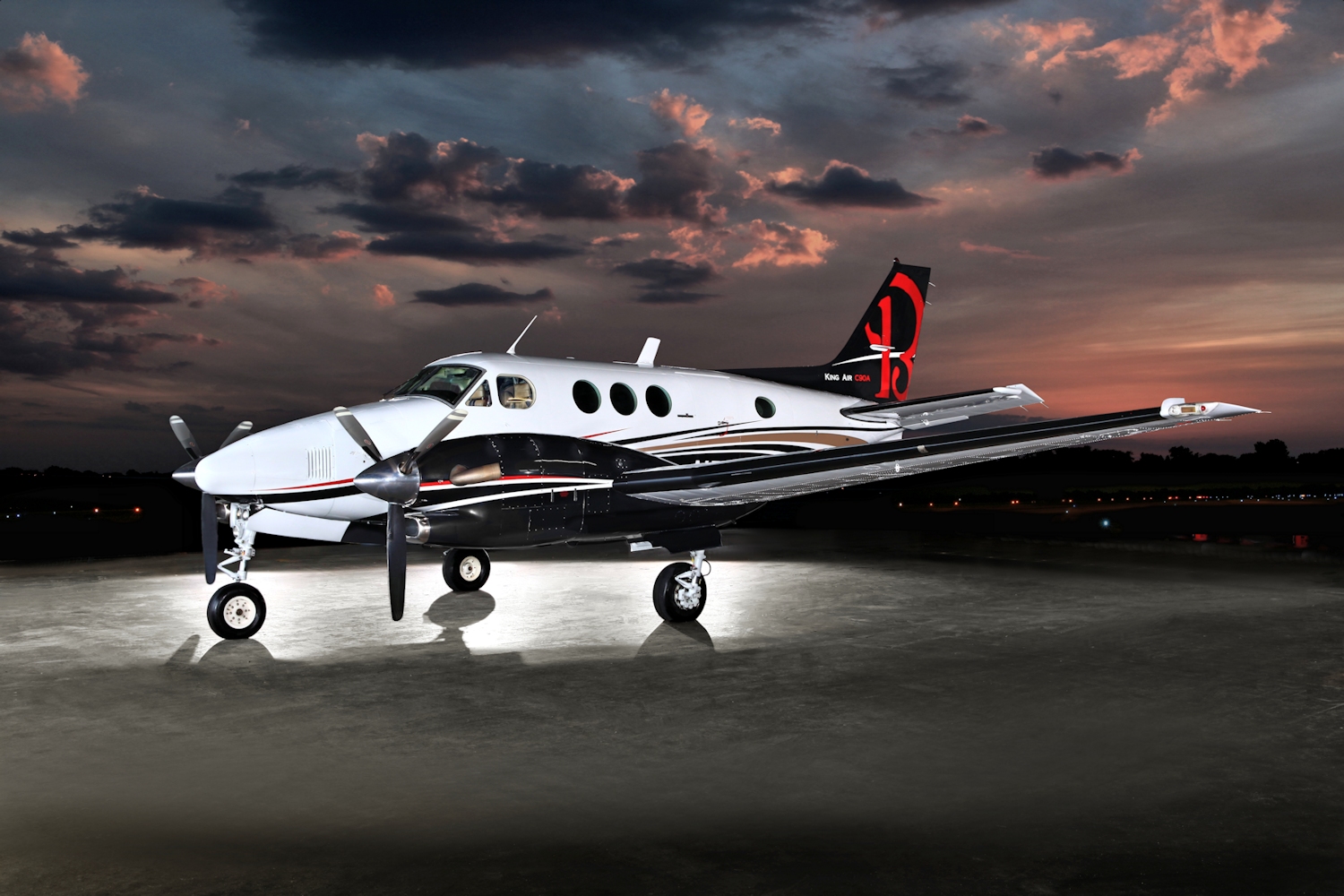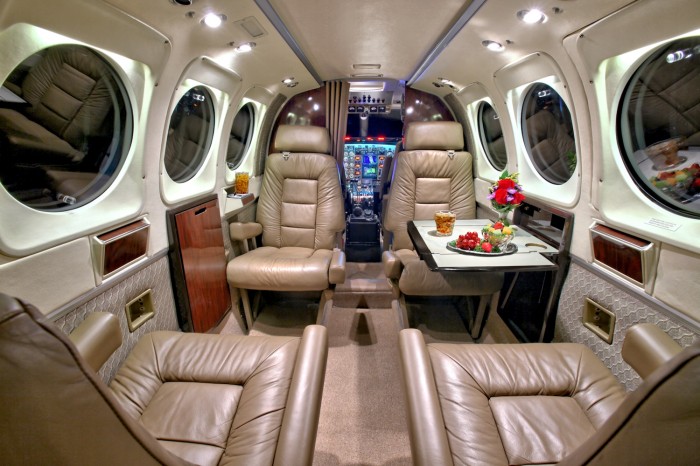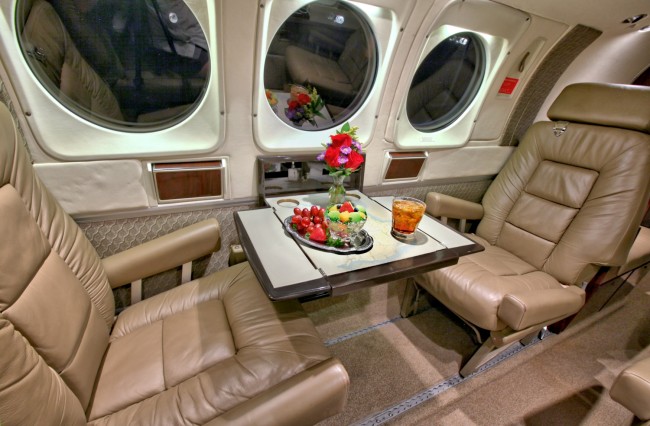

Flying the Beechcraft King Air C90A by Mark Schweibold
The King Air 90 series remains incredibly popular having all the qualities one desires in an aircraft: dependable, stylish and consistent. Nonetheless, it was the C series innovative upgrades and features that transformed this iconic platform. Launched in 1971, it was the King Air C90 Series that provided this brand’s backbone. The new model had stronger engines and wings that enhanced its performance dramatically, and soon, the C90 gained a reputation for its robustness. Today, the King Air C90 series remains highly valued in the aircraft market for its economical price and operating efficiencies, durability and cabin-class amenities.
Why the King Air C90 Series stands out
- Though certified for single pilot operation, the C90A can carry up to seven passengers and their baggage
- Allowing for shorter trip times and lower operating costs, the King Air C90 Series features more powerful Pratt & Whitney PT6A-21 engines and a significantly longer wingspan than earlier models. These items allow an increase in maximum takeoff weights, better runway performance, higher speeds and lower fuel flows.
- The all-weather, twin-engine, turboprop aircraft is as rugged and sturdy as it gets with a long history of reliability improvements.
- Commonly referred to as the SUV of the sky, it can fly long hours.
- The Executive configured cabin is preferred for business travel.
The King Air c90—Features and Highlights
- Twin turboprop engines
- 240 mph cruise
- 7 Passengers
- Pressurized cabin
- Executive seating
- Climate controlled cabin
- Large viewing windows
- Conference tables
- Reading lights
- Adjustable seating
- Leather interior
- Storage for hot and cold refreshments
All King Air C90A models are easily upgradable with Multifunction displays, Chartview and NEXRAD weather avionics suites. The user interface, presentation and capabilities of these avionics provide a low-cost improvement in situational awareness and reduce cockpit workload. The construction quality of the aircraft is exceptional, both in fit and finish, and the pilot seat is far more adjustable to accommodate a range of pilots.
Flying the C90A
The start procedure for the C90A is typical of turbine aircraft: right ignition and engine-start switch on; condition lever moved from fuel cutoff to low idle as the compressor shaft rotational speed (N1) stabilizes above 12 percent; check for ignition, fuel flow and interstage turbine temperature (ITT) rise (indication within 10 seconds of moving condition lever, but not to exceed 1,090°C); check oil pressure; and move the condition lever to high idle as N1 reaches 51 percent, at which time the ignition and engine-start switch is turned off and the right generator is activated by moving its switch to “reset,” then “on.” When the load on the right generator falls below 50 percent, the same start procedure is initiated for the left engine. For the pilot transitioning from a recip to a turboprop, the simplicity of starting a turbine will be a pleasant surprise. With one engine operating at low power, such as just after starting, N1 must be kept sufficiently high to prevent engine lugging due to its 250-amp generator requiring too much power, which in turn would slow N1 and cause an excessive ITT. Beech publishes a simple schedule of minimum N1 versus generator load, requiring 51-percent N1 for loads below 50-percent generator capacity and ranging up to 70-percent N1 (high idle on the condition lever) for loads above 80 percent. With two engines operating, the amperage required for ground activities normally is sufficiently low that generator loads stay below 50 percent and the condition levers can remain in low idle.
The C90A is a simple aircraft to operate in all modes, especially on the ground. Steering is through a mechanical linkage between the rudder pedals and the nosewheel, and it is responsive without being over sensitive. Nosewheel steering and differential power are sufficient for handling the majority of taxiing requirements; differential braking is rarely needed. Setting power for takeoff requires somewhat the same technique as operating a turbocharged recip that doesn’t have a means of limiting manifold pressure. Pratt & Whitney PT6As have the capability of producing too much power on takeoff, exceeding either torque or ITT limits (or both) simply because the pilot advanced the power levers too far during the takeoff roll. Furthermore, as the aircraft accelerates from a standstill to its initial climb speed, the ram effect of air flowing into the nacelle causes torque to increase even though the power levers remain set.
Comfortable control forces during rotation plus well-mannered handling qualities at liftoff and during the climb make the C90A a pleasant aircraft to fly — VFR as well as IFR. For our departure, the C90A responds nicely to an initial pitch attitude of about 15 degrees and held until confident that all obstacles are cleared and a establishing s cruise-climb attitude. The aircraft has good dynamic stability in pitch during the climb, resulting in impressive airspeed hold and minimal demands on the pilot concerning pitch attitude. Spiral stability also is good, thus the C90A tends to hold a heading very well.
In cruise, the C90A demonstrates very good stability about all axes, and it is indeed a pleasure to fly. The cabin sound levels are comfortable; conversations can be held without straining to be heard. Vibration levels also are low. Control feel are typical King Air: solid and effective. The C90A exhibits minimal trim changes with flap and gear extension, and it has very good speed stability in the approach configuration. The aircraft handles nicely on final, with power providing good control over glidepath angle; also, there are no adverse tendencies toward Dutch roll. Landing a C90A, like landing its predecessors, is a breeze. Control loads for the flare are noticeable but not excessive, and tracking once on the ground is straight.
Whether selected by the first-time turbine buyer or the seasoned flight department, the C90A King Air is an attractive, capable aircraft that can be flown easily by one or two pilots. Workload during normal operations is kept to reasonable levels due to the aircraft’s panel design and improved systems, and such features as rudder bias and automatic load-shedding of certain electrics are significant aids during emergencies. Also, the C90A exudes the classic stuff of Beech King Airs, and that’s appealing no matter how many pilots are in the front office.
Ownership Made Easy and Affordable
To be successful and popular is one thing. But to sustain it over 50 years and continue to grow from strength to strength needs something truly special. However, once the King Air’s earliest models took to the skies, there was no looking back. Here was an aircraft that delivered. It was quiet, classy, smooth and comfortable. The demand for the King Air’s twin engine turboprops rose dramatically and it soon became the darling of the executive, corporate world. Today, the King Air models are taken as the gold standard for quality and reliability. Pilots, patrons, operators or amateur fliers; the brand evokes a reverential fondness and an ardent desire to own it. To see how affordable it is to own and operate a King Air C90A, request an ownership cash flow Click Here.
Click Here for a full presentation on the C90A featured in the article above. For more information on C90A performance parameters Click Here.



